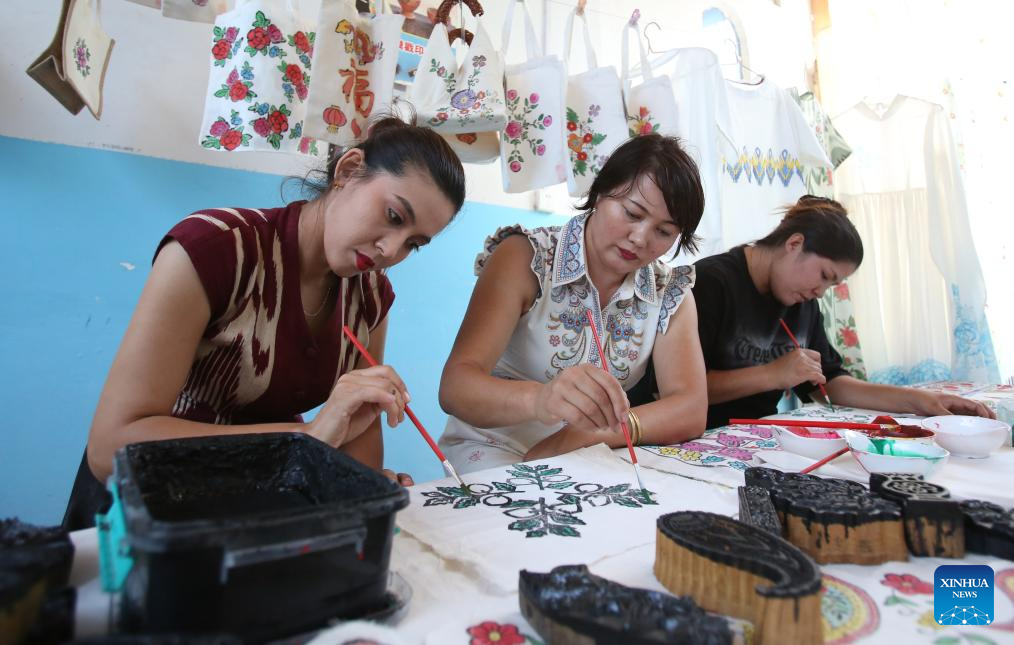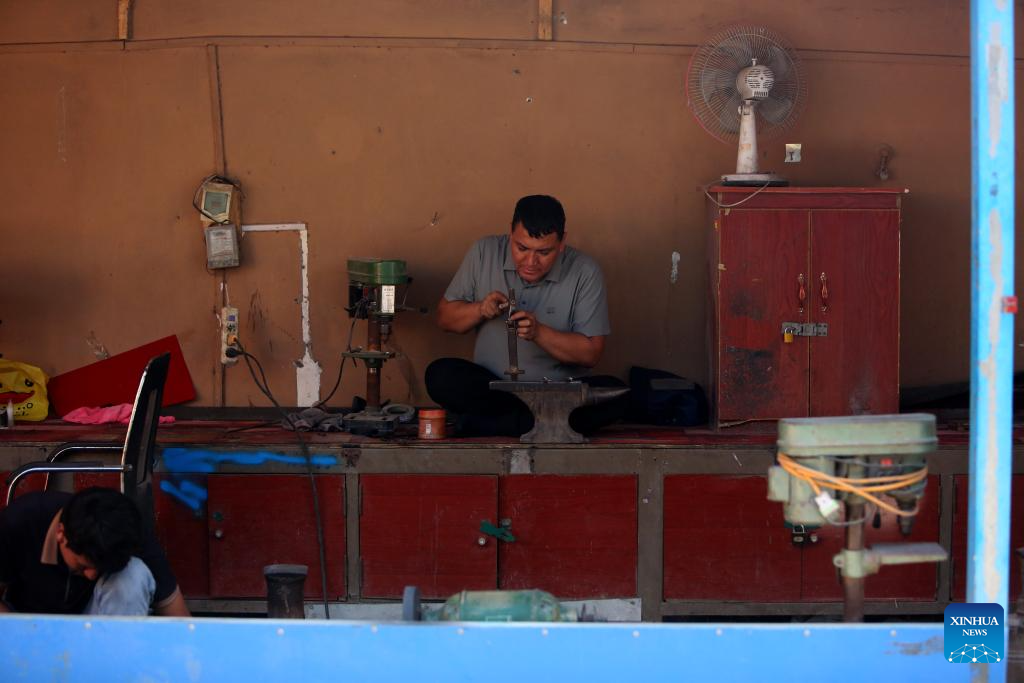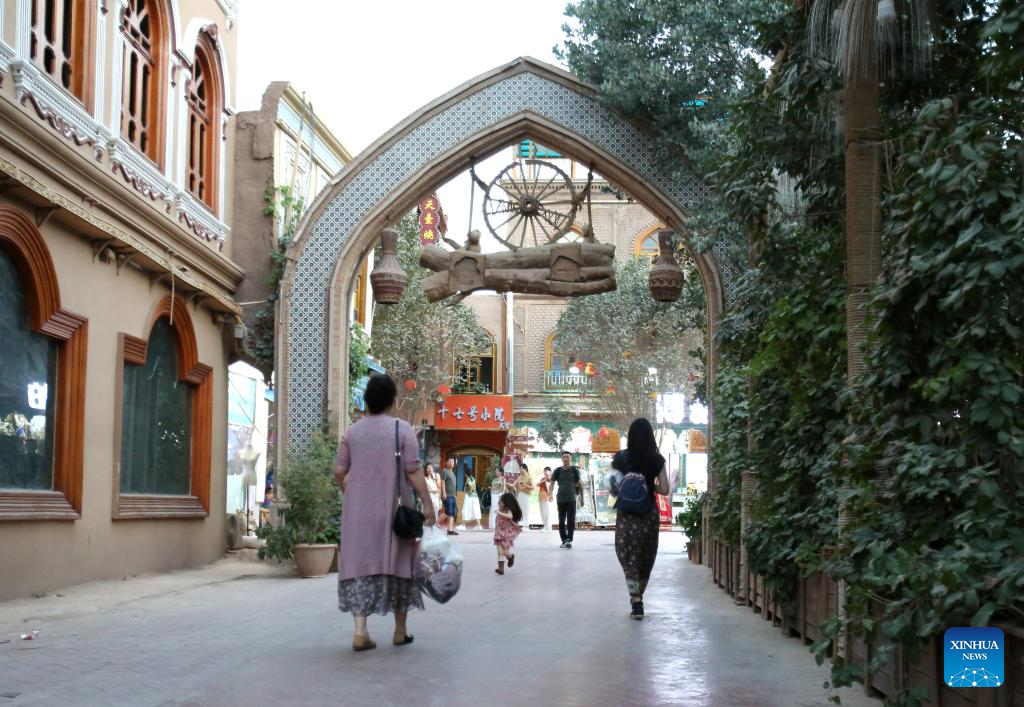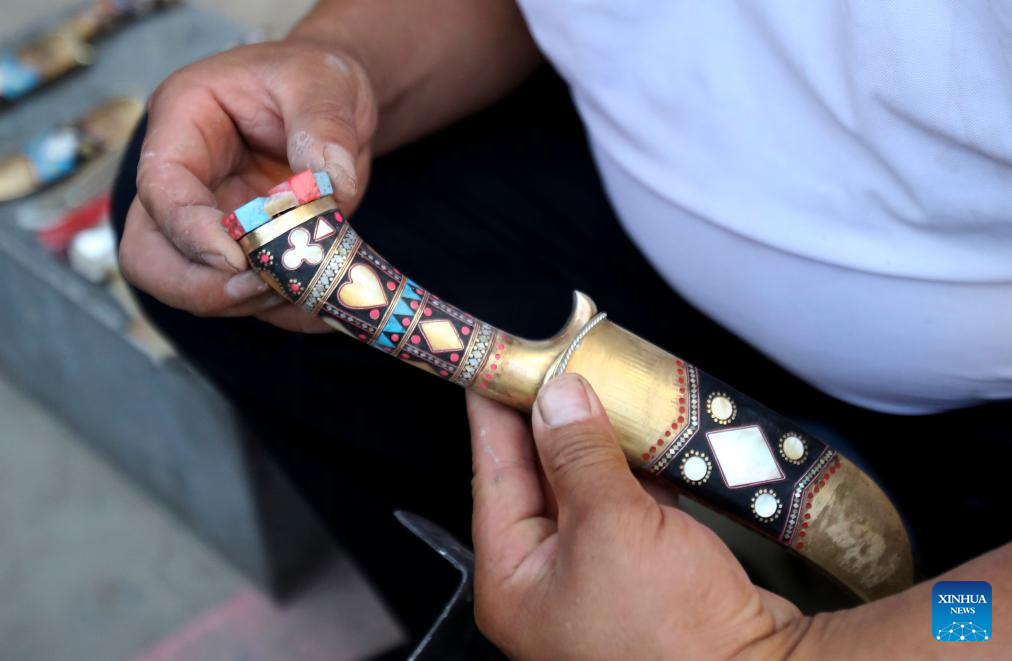


A Pakistani tourist (2nd R, front) dances with a staff member at a homestay, in the Kashgar Ancient City scenic spot, northwest China's Xinjiang Uygur Autonomous Region, Sept. 10, 2025. The ancient city of Kashgar, located in southwestern Xinjiang, served as a vital transportation hub connecting China with Central Asia and South Asia in ancient times. The confluence of diverse ethnic cultures in this region has given rise to a wealth of historical and cultural treasures.
Today, Kashgar has harnessed its cultural and geographical advantages, transforming into a unique tourist destination that blends history and modernity. (Xinhua/Cheng Li)

This photo shows a herbal tea house at the Kashgar Ancient City scenic spot, northwest China's Xinjiang Uygur Autonomous Region, Sept. 10, 2025. The ancient city of Kashgar, located in southwestern Xinjiang, served as a vital transportation hub connecting China with Central Asia and South Asia in ancient times. The confluence of diverse ethnic cultures in this region has given rise to a wealth of historical and cultural treasures.
Today, Kashgar has harnessed its cultural and geographical advantages, transforming into a unique tourist destination that blends history and modernity. (Xinhua/Cheng Li)

County-level inheritors of the wooden stamp printed fabric, a national-level intangible cultural heritage, work in a village in Yengisar County of Kashgar, northwest China's Xinjiang Uygur Autonomous Region, Sept. 11, 2025. The ancient city of Kashgar, located in southwestern Xinjiang, served as a vital transportation hub connecting China with Central Asia and South Asia in ancient times. The confluence of diverse ethnic cultures in this region has given rise to a wealth of historical and cultural treasures.
Today, Kashgar has harnessed its cultural and geographical advantages, transforming into a unique tourist destination that blends history and modernity. (Xinhua/Cheng Li)

A villager makes a knife in a village in Yengisar County of Kashgar, northwest China's Xinjiang Uygur Autonomous Region, Sept. 11, 2025. The Yengisar knife, a local specialty known for its exquisite shape, beautiful decoration and sharp edge, has been listed as a national intangible cultural heritage. The ancient city of Kashgar, located in southwestern Xinjiang, served as a vital transportation hub connecting China with Central Asia and South Asia in ancient times. The confluence of diverse ethnic cultures in this region has given rise to a wealth of historical and cultural treasures.
Today, Kashgar has harnessed its cultural and geographical advantages, transforming into a unique tourist destination that blends history and modernity. (Xinhua/Cheng Li)

A villager makes a knife in a village in Yengisar County of Kashgar, northwest China's Xinjiang Uygur Autonomous Region, Sept. 11, 2025. The Yengisar knife, a local specialty known for its exquisite shape, beautiful decoration and sharp edge, has been listed as a national intangible cultural heritage. The ancient city of Kashgar, located in southwestern Xinjiang, served as a vital transportation hub connecting China with Central Asia and South Asia in ancient times. The confluence of diverse ethnic cultures in this region has given rise to a wealth of historical and cultural treasures.
Today, Kashgar has harnessed its cultural and geographical advantages, transforming into a unique tourist destination that blends history and modernity. (Xinhua/Cheng Li)

Tourists visit the Kashgar Ancient City scenic spot, northwest China's Xinjiang Uygur Autonomous Region, Sept. 10, 2025. The ancient city of Kashgar, located in southwestern Xinjiang, served as a vital transportation hub connecting China with Central Asia and South Asia in ancient times. The confluence of diverse ethnic cultures in this region has given rise to a wealth of historical and cultural treasures.
Today, Kashgar has harnessed its cultural and geographical advantages, transforming into a unique tourist destination that blends history and modernity. (Xinhua/Cheng Li)

Salamatgul, owner of a homestay, poses for photos in the Kashgar Ancient City scenic spot, northwest China's Xinjiang Uygur Autonomous Region, Sept. 10, 2025. The ancient city of Kashgar, located in southwestern Xinjiang, served as a vital transportation hub connecting China with Central Asia and South Asia in ancient times. The confluence of diverse ethnic cultures in this region has given rise to a wealth of historical and cultural treasures.
Today, Kashgar has harnessed its cultural and geographical advantages, transforming into a unique tourist destination that blends history and modernity. (Xinhua/Cheng Li)

A villager makes a knife in a village in Yengisar County of Kashgar, northwest China's Xinjiang Uygur Autonomous Region, Sept. 11, 2025. The Yengisar knife, a local specialty known for its exquisite shape, beautiful decoration and sharp edge, has been listed as a national intangible cultural heritage. The ancient city of Kashgar, located in southwestern Xinjiang, served as a vital transportation hub connecting China with Central Asia and South Asia in ancient times. The confluence of diverse ethnic cultures in this region has given rise to a wealth of historical and cultural treasures.
Today, Kashgar has harnessed its cultural and geographical advantages, transforming into a unique tourist destination that blends history and modernity. (Xinhua/Cheng Li)

Tourists watch a performance at a homestay, in the Kashgar Ancient City scenic spot, northwest China's Xinjiang Uygur Autonomous Region, Sept. 10, 2025. The ancient city of Kashgar, located in southwestern Xinjiang, served as a vital transportation hub connecting China with Central Asia and South Asia in ancient times. The confluence of diverse ethnic cultures in this region has given rise to a wealth of historical and cultural treasures.
Today, Kashgar has harnessed its cultural and geographical advantages, transforming into a unique tourist destination that blends history and modernity. (Xinhua/Cheng Li)

A tourist poses for photos at Kashgar Ancient City scenic spot, northwest China's Xinjiang Uygur Autonomous Region, Sept. 10, 2025. The ancient city of Kashgar, located in southwestern Xinjiang, served as a vital transportation hub connecting China with Central Asia and South Asia in ancient times. The confluence of diverse ethnic cultures in this region has given rise to a wealth of historical and cultural treasures.
Today, Kashgar has harnessed its cultural and geographical advantages, transforming into a unique tourist destination that blends history and modernity. (Xinhua/Cheng Li)

Tourists dance with staff members at a homestay, in the Kashgar Ancient City scenic spot, northwest China's Xinjiang Uygur Autonomous Region, Sept. 10, 2025. The ancient city of Kashgar, located in southwestern Xinjiang, served as a vital transportation hub connecting China with Central Asia and South Asia in ancient times. The confluence of diverse ethnic cultures in this region has given rise to a wealth of historical and cultural treasures.
Today, Kashgar has harnessed its cultural and geographical advantages, transforming into a unique tourist destination that blends history and modernity. (Xinhua/Cheng Li)

Students make pottery wares in a village in Yengisar County of Kashgar, northwest China's Xinjiang Uygur Autonomous Region, Sept. 11, 2025. The ancient city of Kashgar, located in southwestern Xinjiang, served as a vital transportation hub connecting China with Central Asia and South Asia in ancient times. The confluence of diverse ethnic cultures in this region has given rise to a wealth of historical and cultural treasures.
Today, Kashgar has harnessed its cultural and geographical advantages, transforming into a unique tourist destination that blends history and modernity. (Xinhua/Cheng Li)

Villagers perform for tourists in a village in Yengisar County of Kashgar, northwest China's Xinjiang Uygur Autonomous Region, Sept. 11, 2025. The ancient city of Kashgar, located in southwestern Xinjiang, served as a vital transportation hub connecting China with Central Asia and South Asia in ancient times. The confluence of diverse ethnic cultures in this region has given rise to a wealth of historical and cultural treasures.
Today, Kashgar has harnessed its cultural and geographical advantages, transforming into a unique tourist destination that blends history and modernity. (Xinhua/Cheng Li)

Tourists pose for a group photo at the Kashgar Ancient City scenic spot, northwest China's Xinjiang Uygur Autonomous Region, Sept. 10, 2025. The ancient city of Kashgar, located in southwestern Xinjiang, served as a vital transportation hub connecting China with Central Asia and South Asia in ancient times. The confluence of diverse ethnic cultures in this region has given rise to a wealth of historical and cultural treasures.
Today, Kashgar has harnessed its cultural and geographical advantages, transforming into a unique tourist destination that blends history and modernity. (Xinhua/Cheng Li)

Villagers make naans for tourists in a village in Yengisar County of Kashgar, northwest China's Xinjiang Uygur Autonomous Region, Sept. 11, 2025. The ancient city of Kashgar, located in southwestern Xinjiang, served as a vital transportation hub connecting China with Central Asia and South Asia in ancient times. The confluence of diverse ethnic cultures in this region has given rise to a wealth of historical and cultural treasures.
Today, Kashgar has harnessed its cultural and geographical advantages, transforming into a unique tourist destination that blends history and modernity. (Xinhua/Cheng Li)
点击右上角![]() 微信好友
微信好友
 朋友圈
朋友圈

请使用浏览器分享功能进行分享
